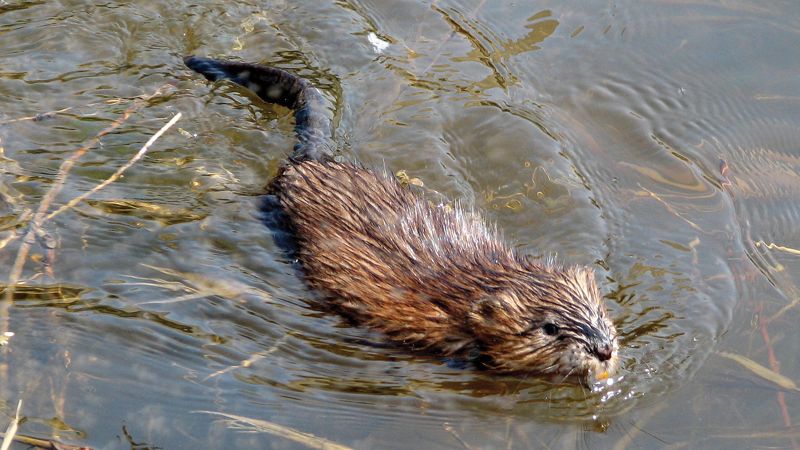Paddling or hiking adjacent to water in the Chesapeake watershed? Keep an eye out for muskrats
A paddling excursion or a marsh-adjacent hike in the Chesapeake watershed might offer a glimpse of a furry back... is it a beaver? A river otter? A nutria? Most likely it is the ubiquitous muskrat. My daily walk in a county park at the headwaters of Locust Cove off Bodkin Creek rewards me with the view of a busy muskrat carrying a mouthful of marsh plants on its way back to its mound shaped lodge.

Muskrats (Ondrata zibethicus) are the most common semiaquatic mammal in the Chesapeake’s ecosystem, and despite the name are not a member of the rat family. Their genus is a Huron/Wyandot name for this native rodent, and their species name is Latin for “musky odored.” Adults use their strong musky odor as a form of communication and as a way of delineating territorial boundaries.
Weighing in at up to four pounds, the small muskrat has a hairless snake-like tail that is compressed laterally on the sides and functions as a rudder. It has thick, shiny fur that can vary in color from brown to black with a lighter color on the throat and undersides. Sharp incisors and rows of molars allow them to neatly bite off grasses. Muskrats are excellent swimmers due to their partially webbed feet. They can spend up to 17 minutes underwater feeding. Their diet is primarily composed of the roots of marsh plants, but they will feed omnivorously as well.
On riverbanks the muskrat will dig a burrow, but in the open marsh they build distinctive mound-shaped lodges that are two to three feet high and can be up to six feet in diameter. They are distinguished from beaver lodges as they are primarily composed of grasses, sedges, and mud. Though they build specialized feeding platforms in addition to their multichambered lodges, they are able to actively bite and chew underwater because they have fur mouth flaps behind their teeth (like a check valve)! Lodges are well insulated and provide dry living spaces and protection from predators.
Typically nocturnal, muskrats are active even in the winter as they can dive below the ice and dig for rootstock of cattail and bulrushes. Their coats grow thicker and are more insulated and water repellant in the cold weather.
Muskrats produce litters of two to five kits and can have multiple litters throughout the year. The kits are fully furred within two weeks and within a month are living on their own. Predation is from raccoons, foxes, raptors, and humans.
Muskrats have been historically trapped for their fur as well as their meat. There is still a trapping season for muskrats or “marsh rabbits” in Eastern Shore vernacular. Dorchester County’s February Outdoor Festival celebrates all things muskrat; one can sample muskrat stew or chili and watch the muskrat skinning championships.
These highly adaptable creatures are thriving despite the many challenges facing our native species. While they may not be as charismatic as the beaver or the river otter, they are gifted marsh engineers and deserve our appreciation for their ability to survive year-round as a warm-blooded mammal in the extremes of the Chesapeake.
by Pamela Tenner Kellett




